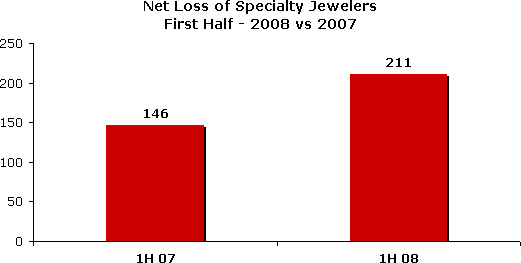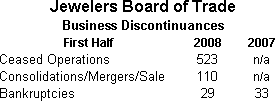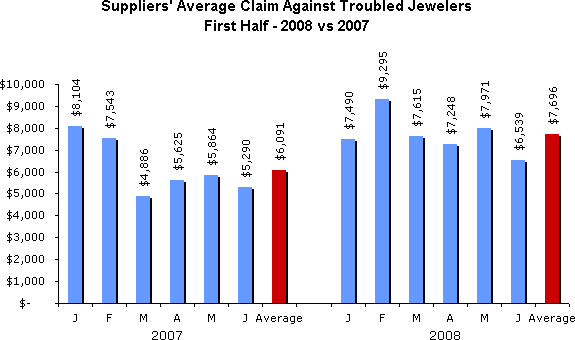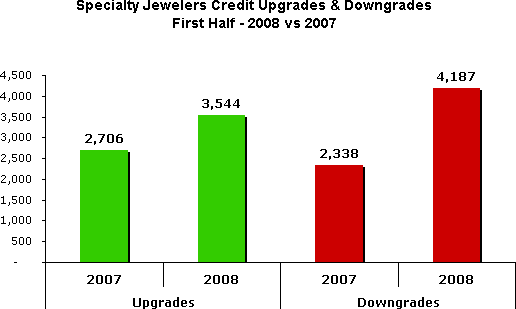IDEX Online Research: U.S. Jewelry Industry Consolidation Accelerates in H1
July 21, 08
During the first half of 2008, the net number of specialty jewelers in the U.S. dropped by 211 companies, according to data recently released by the Jewelers Board of Trade. In the same period last year, the net number of specialty jewelers declined by only 146 companies. At the end of June, there were about 22,830 specialty jewelers in the U.S., based on the Jewelers Board of Trade census.
Typically, when the U.S. economy slows, the number of jewelers going out of business increases. With economic sluggishness, the credit crunch, housing woes and energy prices soaring affecting consumer spending, it is no surprise that jewelry industry consolidation is accelerating in 2008.
Among jewelry suppliers, the number of wholesalers has held steady in the first half, while the number of jewelry manufacturers has declined modestly, according to the census numbers released by the Jewelers Board of Trade.
Jewelers’ Credit Quality Deteriorates
The media tells us that consumer credit quality has deteriorated. Unfortunately, the credit health of specialty jewelers has also weakened. For example, the average size of the credit claim by suppliers against troubled jewelry retailers has risen by 26 percent in the first half of 2008 to $7,696 versus the average of $6,091 for the first half of 2007.
Despite the increase in jewelers who went out of business and the credit claims against those jewelers, there has been a slight year-over-year reduction in the number of bankruptcies. Apparently, many jewelers are running going-out-of-business sales and simply shutting down, rather than filing for bankruptcy.
Outlook: We’re At an Inflection Point
We believe that the jewelry industry is at an inflection point. After benefiting from a growth economy for several years, industry consolidation is expected to accelerate in the face of the softening economy. Consumers have tightened their purse strings and cut back on discretionary purchases such as jewelry.
For the full year, we believe the U.S. jewelry industry will see an increase in the number of jewelers who go out of business. During 2008, we expect to see a net of at least 500 fewer jewelers cease doing business by the end of the year, an increase of 66 percent over last year’s net loss of 300 jewelers. At the end of the year, we look for about 22,550 specialty jewelers.
Loss of Specialty Jewelers Accelerates
In the first half of 2008, the net number of specialty jewelers in the U.S. market fell by 211 companies, a 45 percent increase over the net loss of 146 companies for same period last year. Based on the likelihood that store closings will accelerate in the second half of 2008 due to battered merchants who shut down their stores as a result of the weak economy, we believe that the end-of-year jewelry census will show a reduction of at least 500 merchants during 2008.
The graph below summarizes the increase in the net loss of specialty jewelers during the first half of 2008 with the same period last year.
 Source: JBT |
Business Discontinuances Summarized
The Jewelers Board of Trade began collecting data on “business discontinuances” earlier this year. Unfortunately, there are no comparative figures against last year. In the past, the JBT had been reporting only bankruptcies. Now, however, they have three classes of “business discontinuances”: 1) ceased operations; 2) consolidations/sale/merger; and, 3) bankruptcies.
The following table summarizes the JBT “business discontinuances” analysis.
 Source: JBT |
Suppliers’ Average Credit Claim Against Jewelers Rises
A significant increase in the size of the average credit claim against troubled jewelers does not bode well for the jewelry industry in 2008. While jewelers complain that consumer credit has tightened, and that fewer customer credit applications are approved, this is a bit like the proverbial “pot calling the kettle black.” Jewelers’ credit quality has also deteriorated, according to the Jewelers Board of Trade.
For the first six months of 2008, jewelry suppliers’ average monthly claim against retail jewelers was $7,696, up 26 percent from the prior year’s $6,091.
The graph below summarizes the size of the average claim by month and for the first six months of the 2007 and 2008.

Source: JBT
The Good News
There were two pieces of good news related to the credit health of the jewelry industry during the first half of 2008:
- The average number of monthly supplier claims against retail jewelers dropped to 310 per month from last year’s 317 per month.
- The total number of specialty jeweler bankruptcies which occurred during the first six months of 2008 was 29; last year, 33 specialty jewelers had filed for bankruptcy in the first half of the year. While we classify this as “good news,” it really means that some jewelers have simply dropped out of sight, rather than filing for bankruptcy.
Credit Rating Changes Increase
The Jewelers Board of Trade has been much more active this year with its credit scoring system. In troubled times, it is incumbent for this rating agency to be “ahead of the curve.” It appears that the JBT has done a good job of scoring credit and making adjustments to the credit rating of the jewelry retailers in its data base. JBT operates for the benefit of global jewelry suppliers who sell to U.S. jewelry retailers.
The news about specialty jewelers’ credit scores is not all bad. During the first half of 2008, the JBT raised 3,544 credit ratings, up dramatically from last year’s 2,706 credit rating increases in the first six month period. However, the number of credit score downgrades nearly doubled during the first half of 2008 to 4,187 versus last year’s 2,338 downgrades in the first half.
The graph below illustrates credit upgrades and downgrades for the first half of 2008 versus 2007.

Source: JBT
Jewelry Wholesalers’ Census Unchanged
During the first half of 2008, the number of jewelry wholesalers in the U.S. remained steady. In January, there were 4,570 jewelry wholesalers in the market; in June, the number had risen slightly to 4,574 suppliers.
In the same period a year ago, the number of jewelry wholesalers dropped by 40 companies.
Because of a reclassification by JBT of companies between categories, it is not possible to precisely compare 2007 wholesaler census statistics with 2008 data. However, based on our estimates, it would appear that the number of jewelry wholesalers has declined by less than 1 percent year-over-year.
Jewelry Manufacturers’ Census Declines
The number of jewelry manufacturers declined in the U.S. during the first half of 2008. At the end of June, there were about 3,376 jewelry manufacturers in the U.S., down from 3,412 in January, a decline of just over 1 percent. That’s a modest number for the period. However, ten years ago, there were over 4,500 jewelry manufacturers. While there has been some consolidation among jewelry manufacturers, many of them have moved their operations offshore to regions of the world with lower labor costs.
Because of some category reclassifications by the Jewelers Board of Trade, it is not possible to precisely compare 2007 data with 2008 information. However, based on our estimates, the number of jewelry manufacturers had declined by about 70 companies year-over-year, a reduction of about 2 percent.
How Many Specialty Jewelers Are There in the U.S.?
We regularly get asked how many specialty jewelers operate in the U.S. When we quote figures, we like to have at least three sources for our data. For the U.S. jewelry census, we have three reliable sources for census data: the Jewelers Board of Trade (JBT), the Bureau of Labor Statistics (BLS) and the Department of Commerce.
Census figures vary among these three sources due to differences in definitions. For example, the Jewelers Board of Trade defines chains such as Sterling, which currently has just under 1,400 stores in the U.S. as “one” jeweler. On the other hand, the Department of Commerce uses the term “jewelry establishment,” which is defined as “one store”; thus, Sterling represents nearly 1,400 of the “establishments” in the government census data.
The BLS census includes jewelers who make quarterly reports about wages and other labor information. Those jewelers who do not make quarterly labor reports are generally too small to be of consequence to the industry. Thus, while the math indicates that the JBT database includes about 91 percent of all U.S. jewelers, it actually includes just about every jewelry business of any consequence, in our opinion.
We continue to believe that JBT figures are the most reliable source for jewelry industry census trends. JBT statistics include only those jewelers who are of consequence. In contrast, the government figures include any person who reports that he or she may be in the jewelry business, even if it is a shell business designed for a tax write-off.
Today, our “official” answer to the question of “How many specialty jewelers operate in the U.S. market” would be: “There are about 22,800 companies operating around 29,000 stores.” That’s our story, and we’re sticking with it.